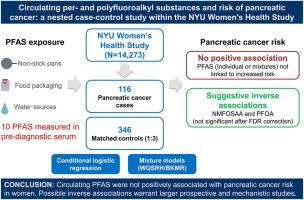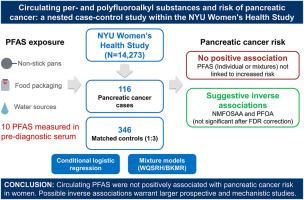Circulating per- and polyfluoroalkyl substances and risk of pancreatic cancer: A nested case-control study within the NYU Women's health study
IF 7.3
2区 环境科学与生态学
Q1 ENVIRONMENTAL SCIENCES
引用次数: 0
Abstract
Per- and polyfluoroalkyl substances (PFAS) are persistent environmental chemicals that have been linked to pancreatic cancer in animal studies, but evidence in humans remains limited. We evaluated associations between pre-diagnostic circulating concentrations of 11 PFAS and pancreatic cancer risk in a nested case-control study within the New York University Women's Health Study, a prospective cohort of 14,273 women. Serum samples collected prior to diagnosis from 116 pancreatic cancer cases and 346 matched controls were analyzed for PFAS levels. Associations between individual PFAS and pancreatic cancer risk were assessed using multivariable conditional logistic regression, and mixture effects were examined using repeated holdout weighted quantile sum (WQSRH) regression and Bayesian kernel machine regression (BKMR). Ten PFAS met the inclusion criteria for analysis. In single-chemical models, N-methyl perfluorooctane sulfonamidoacetic acid (NMFOSAA) and perfluorooctanoate (PFOA) were inversely associated with pancreatic cancer risk, but associations did not remain significant after false discovery rate correction. WQSRH models with negative constraints suggested a borderline inverse association with the PFAS mixture, primarily driven by NMFOSAA, PFOA, and perfluoroundecanoate (PFUNDA), while no significant associations were observed in positively constrained WQSRH or BKMR models. Overall, these findings do not support a positive association between circulating PFAS and pancreatic cancer risk in women. Although some compounds showed suggestive inverse associations, the overall findings indicate no clear link between PFAS exposure and pancreatic cancer risk.


循环全氟烷基和多氟烷基物质与胰腺癌风险:纽约大学妇女健康研究中的巢式病例对照研究
全氟和多氟烷基物质(PFAS)是持久性环境化学物质,在动物研究中与胰腺癌有关,但在人类身上的证据仍然有限。我们在纽约大学妇女健康研究的一项嵌套病例对照研究中评估了诊断前循环11 PFAS浓度与胰腺癌风险之间的关系,该研究纳入了14273名妇女的前瞻性队列。对116例胰腺癌患者和346例匹配对照者诊断前采集的血清样本进行PFAS水平分析。使用多变量条件逻辑回归评估个体PFAS与胰腺癌风险之间的关联,并使用重复持位加权分位数和(WQSRH)回归和贝叶斯核机回归(BKMR)检验混合效应。10例PFAS符合纳入标准。在单一化学模型中,n -甲基全氟辛烷磺酰胺乙酸(NMFOSAA)和全氟辛酸盐(PFOA)与胰腺癌风险呈负相关,但在错误发现率校正后,相关性不再显著。具有负约束的WQSRH模型表明,与PFAS混合物呈临界负相关,主要由NMFOSAA、PFOA和全氟正甲酸(PFUNDA)驱动,而在正约束的WQSRH或BKMR模型中未观察到显著关联。总的来说,这些发现不支持循环PFAS与女性胰腺癌风险之间的正相关。尽管一些化合物显示出暗示的负相关,但总体发现表明PFAS暴露与胰腺癌风险之间没有明确的联系。
本文章由计算机程序翻译,如有差异,请以英文原文为准。
求助全文
约1分钟内获得全文
求助全文
来源期刊

Environmental Pollution
环境科学-环境科学
CiteScore
16.00
自引率
6.70%
发文量
2082
审稿时长
2.9 months
期刊介绍:
Environmental Pollution is an international peer-reviewed journal that publishes high-quality research papers and review articles covering all aspects of environmental pollution and its impacts on ecosystems and human health.
Subject areas include, but are not limited to:
• Sources and occurrences of pollutants that are clearly defined and measured in environmental compartments, food and food-related items, and human bodies;
• Interlinks between contaminant exposure and biological, ecological, and human health effects, including those of climate change;
• Contaminants of emerging concerns (including but not limited to antibiotic resistant microorganisms or genes, microplastics/nanoplastics, electronic wastes, light, and noise) and/or their biological, ecological, or human health effects;
• Laboratory and field studies on the remediation/mitigation of environmental pollution via new techniques and with clear links to biological, ecological, or human health effects;
• Modeling of pollution processes, patterns, or trends that is of clear environmental and/or human health interest;
• New techniques that measure and examine environmental occurrences, transport, behavior, and effects of pollutants within the environment or the laboratory, provided that they can be clearly used to address problems within regional or global environmental compartments.
 求助内容:
求助内容: 应助结果提醒方式:
应助结果提醒方式:


